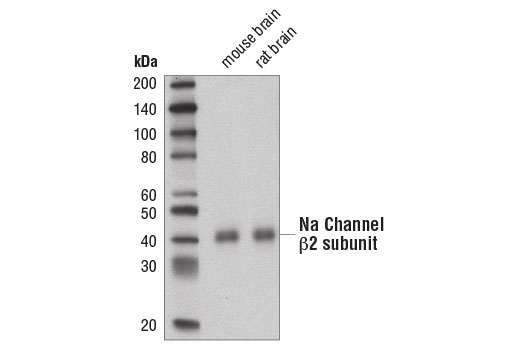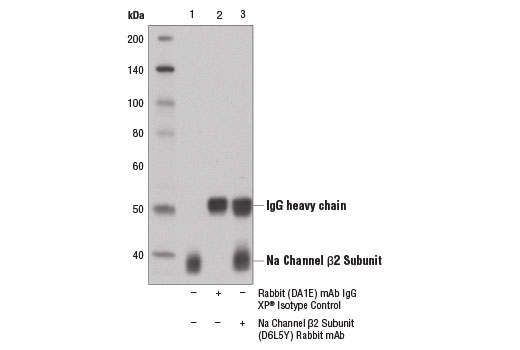WB, IP
M R
Endogenous
37-41
Rabbit IgG
#O60939
6327
Product Information
Product Usage Information
| Application | Dilution |
|---|---|
| Western Blotting | 1:1000 |
| Immunoprecipitation | 1:50 |
Storage
Specificity / Sensitivity
Species Reactivity:
Mouse, Rat
Source / Purification
Monoclonal antibody is produced by immunizing animals with a synthetic peptide corresponding to residues surrounding Leu90 of mouse Na channel β2 subunit protein.
Background
Mammalian voltage-gated sodium channels (VGSCs) are composed of a pore-forming α subunit and one or more regulatory β subunits (1). Four separate genes (SCN1B-SCN4B) encode the five mammalian β subunits β1, β1B, β2, β3, and β4. In general, β subunit proteins are type I transmembrane proteins, with the exception of secreted β1B protein (reviewed in 2). β subunits regulate α subunit gating and kinetics, which controls cell excitability (3,4). Sodium channel β subunits also function as Ig superfamily cell adhesion molecules that regulate cell adhesion and migration (5,6). Additional research reveals sequential processing of β subunit proteins by β-secretase (BACE1) and γ secretase, resulting in ectodomain shedding of β subunit and generation of an intracellular carboxy-terminal fragment (CTF). Generation of the CTF is thought to play a role in cell adhesion and migration (7,8). Multiple studies demonstrate a link between β subunit gene mutations and a number of disorders, including epilepsy, cardiac arrhythmia, multiple sclerosis, neuropsychiatric disorders, neuropathy, inflammatory pain, and cancer (9-13).
The sodium channel β2 subunit (SCN2B) plays a role in the assembly and functioning of cell surface sodium channels (14). Mutations in the corresponding SCN2B gene may be associated with a form of atrial fibrillation and at least one identified case of Brugada syndrome (15,16). Research using a rat model of spared nerve injury (SNI) suggests that the β2 subunit may be involved in the generation of neuropathic pain (17).
- Catterall, W.A. (1992) Physiol Rev 72, S15-48.
- Catterall, W.A. (2012) J Physiol 590, 2577-89.
- Isom, L.L. et al. (1992) Science 256, 839-42.
- Brackenbury, W.J. and Isom, L.L. (2011) Front Pharmacol 2, 53.
- Isom, L.L. et al. (1995) Cell 83, 433-42.
- Malhotra, J.D. et al. (2000) J Biol Chem 275, 11383-8.
- Wong, H.K. et al. (2005) J Biol Chem 280, 23009-17.
- Kim, D.Y. et al. (2005) J Biol Chem 280, 23251-61.
- Wallace, R.H. et al. (1998) Nat Genet 19, 366-70.
- Lopez-Santiago, L.F. et al. (2007) J Mol Cell Cardiol 43, 636-47.
- Chioni, A.M. et al. (2009) Int J Biochem Cell Biol 41, 1216-27.
- O'Malley, H.A. et al. (2009) Mol Cell Neurosci 40, 143-55.
- Valdivia, C.R. et al. (2010) Cardiovasc Res 86, 392-400.
- Schmidt, J.W. and Catterall, W.A. (1986) Cell 46, 437-44.
- Watanabe, H. et al. (2009) Circ Arrhythm Electrophysiol 2, 268-75.
- Riuró, H. et al. (2013) Hum Mutat 34, 961-6.
- Pertin, M. et al. (2005) J Neurosci 25, 10970-80.
Species Reactivity
Species reactivity is determined by testing in at least one approved application (e.g., western blot).
Western Blot Buffer
IMPORTANT: For western blots, incubate membrane with diluted primary antibody in 5% w/v BSA, 1X TBS, 0.1% Tween® 20 at 4°C with gentle shaking, overnight.
Applications Key
WB: Western Blotting IP: Immunoprecipitation
Cross-Reactivity Key
H: human M: mouse R: rat Hm: hamster Mk: monkey Vir: virus Mi: mink C: chicken Dm: D. melanogaster X: Xenopus Z: zebrafish B: bovine Dg: dog Pg: pig Sc: S. cerevisiae Ce: C. elegans Hr: horse GP: Guinea Pig Rab: rabbit All: all species expected
Trademarks and Patents
Limited Uses
Except as otherwise expressly agreed in a writing signed by a legally authorized representative of CST, the following terms apply to Products provided by CST, its affiliates or its distributors. Any Customer's terms and conditions that are in addition to, or different from, those contained herein, unless separately accepted in writing by a legally authorized representative of CST, are rejected and are of no force or effect.
Products are labeled with For Research Use Only or a similar labeling statement and have not been approved, cleared, or licensed by the FDA or other regulatory foreign or domestic entity, for any purpose. Customer shall not use any Product for any diagnostic or therapeutic purpose, or otherwise in any manner that conflicts with its labeling statement. Products sold or licensed by CST are provided for Customer as the end-user and solely for research and development uses. Any use of Product for diagnostic, prophylactic or therapeutic purposes, or any purchase of Product for resale (alone or as a component) or other commercial purpose, requires a separate license from CST. Customer shall (a) not sell, license, loan, donate or otherwise transfer or make available any Product to any third party, whether alone or in combination with other materials, or use the Products to manufacture any commercial products, (b) not copy, modify, reverse engineer, decompile, disassemble or otherwise attempt to discover the underlying structure or technology of the Products, or use the Products for the purpose of developing any products or services that would compete with CST products or services, (c) not alter or remove from the Products any trademarks, trade names, logos, patent or copyright notices or markings, (d) use the Products solely in accordance with CST Product Terms of Sale and any applicable documentation, and (e) comply with any license, terms of service or similar agreement with respect to any third party products or services used by Customer in connection with the Products.

